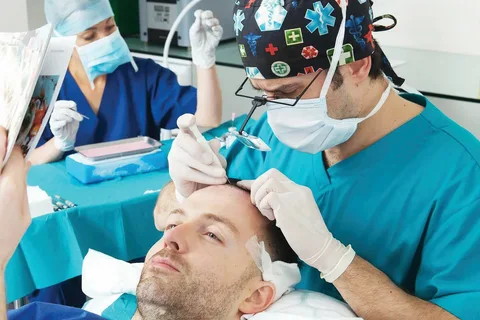Hair loss is often thought of as a cosmetic issue, but for many, it represents a deeper emotional struggle tied to confidence, self-image, and identity. Thankfully, the science of hair restoration has advanced dramatically over the past decade – evolving from basic grafting techniques to precise, minimally invasive procedures that deliver natural-looking, permanent results.
As we move through 2025, leading hair transplant clinics in Mumbai continue to refine themselves with innovations in robotics, regenerative medicine, and post-operative care. But to understand what truly works today, it’s essential to first grasp the biology behind hair growth – and how science now uses that knowledge to restore what time and genetics have taken away.
1. How Hair Actually Grows
Each strand of hair grows from a follicle — a tiny, tube-like structure located in the skin. These follicles go through a recurring cycle consisting of three key phases:
- Anagen (Growth phase): Lasts 2–7 years and determines the length of the hair.
- Catagen (Transition phase): A brief, two-week period where growth stops, and the follicle begins to shrink.
- Telogen (Resting phase): Lasts around 3 months before the hair falls and the cycle restarts.
When hair loss occurs, it’s usually because the anagen phase shortens while the telogen phase lengthens – meaning fewer hairs are growing, and more are shedding.
Understanding this biology allows specialists to manipulate follicular activity – stimulating dormant follicles and relocating healthy ones – to restore balanced growth.
2. The Evolution of Hair Transplant Techniques
The early days of hair transplantation, particularly during the 1980s and 1990s, were marked by “plug” methods that often produced unnatural results. Over time, the field evolved toward more sophisticated microsurgical approaches.
The two most commonly used methods today are:
- FUT (Follicular Unit Transplantation): A strip of scalp is removed from the donor area (usually the back of the head), and follicular units are dissected under a microscope before being implanted into thinning areas.
- FUE (Follicular Unit Extraction): Individual follicular units are extracted one by one using tiny punches, leaving minimal scarring and faster recovery.
Both techniques have high success rates when performed by skilled professionals, though FUE has become the more popular choice in 2025 due to its precision and minimal downtime.
Clinics like Bloom Hair Transplant specialise in modern variations of these techniques, combining them with advanced tools and regenerative support for improved survival rates and aesthetic results.
3. The Rise of Robotics and Automation
In 2025, robotics has become one of the most significant advancements in hair restoration. Robotic-assisted systems like ARTAS and NeoGraft have transformed the precision and consistency of FUE extractions.
These devices use AI-guided algorithms and real-time imaging to identify and harvest optimal follicles while minimising human error. The result is a faster, more accurate procedure that reduces trauma to both donor and recipient sites.
Automation also improves graft survival rates, as each follicle is handled gently and implanted at the correct depth and angle. This level of accuracy ensures that the outcome looks completely natural – even up close.
4. Regenerative Science – The Role of PRP and Growth Factors
Beyond transplantation itself, regenerative therapies now play a crucial role in enhancing results. One of the most widely used is Platelet-Rich Plasma (PRP) therapy – a process that uses the patient’s own blood to extract growth factors that promote healing and follicular regeneration.
When injected into the scalp after a transplant, PRP boosts graft survival and accelerates recovery by improving vascularisation and reducing inflammation.
Other innovations include the use of Exosomes, microscopic vesicles rich in RNA and proteins that stimulate cellular repair and communication. Together, these regenerative treatments bridge the gap between surgery and biology – helping follicles thrive in their new environment.
5. Precision Implantation – Designing a Natural Hairline
One of the most overlooked aspects of a successful transplant is aesthetic design. Science may handle the technical side, but artistry determines the outcome.
Modern hairline design considers facial proportions, age, gender, and natural growth patterns. Using 3D imaging and digital mapping tools, surgeons now create personalised implantation plans that mimic the natural direction and density of hair.
Angles, spacing, and thickness are calibrated precisely – ensuring that the new hairline blends seamlessly with existing hair. This combination of technology and artistry is what differentiates a good transplant from a great one.
6. The Healing Process and Graft Survival
The science doesn’t stop once the transplant is done — post-operative care is just as critical. The first 10 days are vital for graft anchoring, followed by a “shedding phase” where transplanted hair falls temporarily before regrowth begins.
Typically, visible results start appearing around 4–6 months, with full density achieved within 12–18 months. Factors like scalp health, circulation, and lifestyle play key roles in graft survival.
This is why leading hair transplant clinics take a comprehensive approach – guiding patients through pre-surgery preparation, post-surgery nutrition, and follow-up care that ensures long-term success.
7. What’s New in 2025 – Stem Cells and Follicle Cloning
The future of hair restoration lies in cellular regeneration. In 2025, ongoing research into stem cell therapy and follicle cloning shows remarkable promise. Scientists are now able to replicate existing hair follicles in laboratory conditions and reintroduce them into the scalp.
Although still in experimental stages, follicle cloning could one day eliminate the need for donor areas – allowing unlimited follicle availability for even advanced baldness cases.
Similarly, stem cell-derived growth factors are being explored to rejuvenate miniaturised follicles, potentially reversing early-stage hair loss without surgery.
While not yet mainstream, these developments mark an exciting new chapter in the science of hair restoration.
Understanding Limitations and Expectations
Despite scientific progress, hair transplants aren’t magic. Results depend on several factors – donor hair availability, scalp condition, and the patient’s overall health.
Expectations also play a major role in satisfaction. A realistic understanding of what a transplant can achieve is essential; it can restore coverage and density, but it cannot alter natural growth direction or follicle lifespan beyond biological limits.
Moreover, maintaining healthy habits – balanced nutrition, adequate sleep, and stress control – remains crucial even after surgery to protect the new hair.
The Science of Confidence
While science forms the foundation of modern hair transplantation, the true impact goes far beyond biology. Hair restoration often brings emotional renewal — helping individuals reclaim their confidence, self-esteem, and comfort in social and professional spaces.
Many patients describe the experience not just as a transformation of appearance, but as a turning point in their personal journey – proof that technology, when paired with human understanding, can restore more than just hair.
Where Science Meets Self-Confidence
The science of hair transplants in 2025 is no longer about hiding hair loss — it’s about restoring authenticity. With robotics enhancing precision, regenerative medicine improving recovery, and design principles refining aesthetics, the field has evolved into both a science and an art.
Choosing the right clinic means choosing expertise that extends beyond technology; one that understands biology, design, and emotional impact equally. With the guidance of skilled professionals and cutting-edge science, regaining your hair today is not a dream, but a well-researched, medically proven reality.



